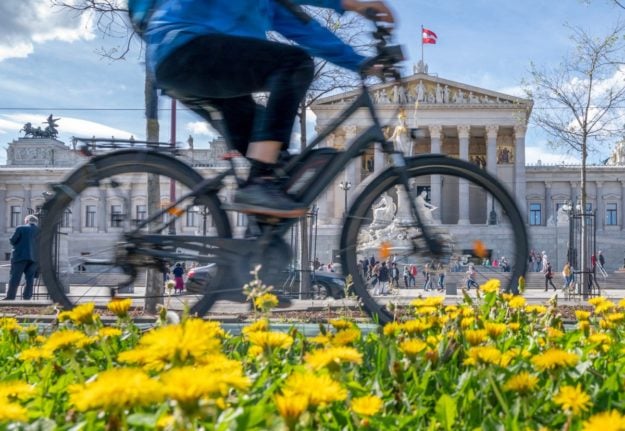If you use a bike to get around in Vienna, it is important to be aware of a few rules and key tips so you stay safe, warm, dry and out of trouble with Austrian police.
Here are 10 things that you should think about before jumping on your bike in Vienna.
Autumn and winter weather can be tough – but so can summer
Vienna weather’s can be brutal sometimes both in the winter, and summer.
During autumn and winter, you will experience rain, wind, and sometimes even snow, although it usually does not last for long. This means you might need to prepare yourself for whatever comes during your ride.
A good idea is to always keep a waterproof and windproof jacket in your backpack and a cap that you can wear under your helmet in case of rain.
If snow is still on the ground, waiting a while before jumping on your bike is better, given the streets may be slippery. Since snow tends to melt quickly in Vienna, you will probably not have to wait long.
Cycling in extreme heat during summer—as heatwaves become longer, harsher, and more common—is also not advised. On days when temperatures are forecast to go over 30C, it might be better to leave the bike at home.
READ ALSO: What you need to know about cycling in Austria
Don’t forget your lights
In Vienna (and Austria in general), you must use front and rear lights when riding during darker hours and during times of reduced visibility, such as fog or heavy rain.
If you do not use bike lights, you put yourself at risk and face a fine of over €20 if caught. Some Vienna police officers are especially vigilant about catching bikers breaking the rules.
READ ALSO: ‘Bike paths too narrow’: How Vienna could be more cycle-friendly
Look for the bike lanes
While biking around Vienna, you often ride alongside cars, trams, and buses. Many cycle lanes are available, but they are not everywhere, and sometimes, you may need to take a longer route to your destination if you want to avoid sharing the road with cars.
A good idea is to check where the bike paths are located and plan your route ahead of time to stay on dedicated paths as much as possible.
Although most car drivers in Vienna tend to show respect to cyclists, complex situations can take place on busy streets, especially during rush hours (mornings and late afternoons after work).
Exploring Vienna by bike during quieter times, such as Sunday mornings, is a good idea to get to know the city, its biking paths, and different roads better.
Do not leave your bike outside overnight
Vienna is not known for being a city where bikes are often stolen, but it can definitely happen. According to the VCÖ, an Austrian public welfare organisation specializing in mobility and transport, 6,328 bikes were stolen in the Austrian capital last year, a decrease of almost seven percent from the year before but still the highest number in Austria in absolute figures.
A good idea is to always bring your bike into your basement, inner yard, or even your flat during the night.
Always lock your parked bike, even if you only go into a shop briefly, the VCÖ says. When locking up, ensure the frame and lock are attached to a bicycle bracket.
“If only the front wheel is attached to the bike stand, there is a risk that the bike will be removed and the rest of the bike stolen,” explained VCÖ spokesperson Christian Gratzer.
The organisation adds that people should replace the quick release on the saddle and front wheel with safety bolts and use a high-quality bicycle lock.
READ MORE: The four best cycling routes in Austria
Always bring some tools with you
While riding around, it is not unlikely that something sometimes breaks, falls off, or starts causing problems. Therefore, it is important to always carry a small kit of the most essential tools with you, such as small screwdrivers and a compact bike pump.
The city has spots with bike pumps in some places, but since you never know when you might need one, it’s a good idea to bring your own.
If you don’t know how to repair minor issues with bikes, such as fixing a flat tire, watching YouTube videos can help.
Watch out for the electric scooters
You are likely to sometimes consider electric scooters as your worst enemies.
They move quickly, can be very quiet, share your lane, and are often ridden by people in groups. Many electric scooter riders tend to change speed quickly.
However, as long as you notice them in time, it should not be a bigger problem.
Avoid drinking too much alcohol
Just like with driving, cycling while under the influence of alcohol is not allowed in Austria. So, you will be fined if you are caught over the limit.
In fact, cyclists are only allowed up to 0.4mg of alcohol per litre of breath. If a breathalyser detects more alcohol in your system, you will be fined based on how much you have consumed.
- From 0.4mg: €800 to €3,700 fine
- From 0.6mg: €1,200 to €4,400
- From 0.8mg: €1,600 to €5,900
- Refusal to test: €1,600 to €5,900
As well as a fine, cyclists can lose a driving licence if caught cycling while drunk. According to the federal government, this is because “riding a bicycle while intoxicated can be an indication of a lack of traffic reliability”. Because of that, authorities may determine that you are not fit to drive and, therefore, revoke your driver’s licence.
READ ALSO: Cycling in Austria – 7 rules you can be fined for breaking
Do not use a bike with thin tyres
Since Vienna is a city filled with tram lanes, using tyres that fit well into them can be dangerous.
In the city, it is almost unavoidable not to ride where you have to cross tram lanes or ride next to them.
Using slightly thicker tyres can make your trip safer. But if you absolutely want to ride your racing bike with thin tires, that should also be safe, as long as you always watch where you go.
Vienna is sometimes hilly
Vienna is not completely flat; if you go higher up in districts such as Ottakring, Hernals, and Währing, you might feel like you are getting a bit of a workout.
During Viennese hot summers, this workout might make you arrive somewhat sweaty at your destination. If you want to avoid this, it is important to plan to wear breathable clothes, bring an extra set, or bike so slowly that you barely start sweating.
Also, it is good to remember that you are allowed to take your bike on the metro outside of rush hours.
Pedestrians share paths with bikes
In many parts of the city, such as along the Ringstraße surrounding the inner district, bikers share paths with pedestrians, sometimes leading to stressful situations.
Many pedestrians do not watch out for bikes, change their walking patterns, or might be listening to music. It is therefore very important to pay attention to your surroundings when you ride in this part of the city.
Take the red lights into consideration
If the light is red, you are not allowed to go through it, even if there are no cars or pedestrians crossing your route.
Another important thing regarding traffic lights is that, if you are unlucky, you might have to wait for the green light multiple times during your bike trip, which could make you arrive later than expected.
A good idea is to start a little earlier to avoid arriving late if you are going somewhere important.




 Please whitelist us to continue reading.
Please whitelist us to continue reading.
Member comments